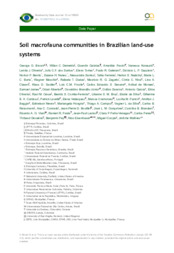Soil macrofauna communities in Brazilian land-use systems.
Soil macrofauna communities in Brazilian land-use systems.
Autoria: BROWN, G. G.; DEMETRIO, W.; GABRIAC, Q.; PASINI, A.; KORASAKI, V.; OLIVEIRA, L.; FRANCHINI, J. C.; TORRES, E.; GALERANI, P. R.; GAZZIERO, D. L. P.; BENITO, N. P.; NUNES, D. H.; SANTOS, A.; FERREIRA, T.; NADOLNY, H. S.; BARTZ, M.; MASCHIO, W.; DUDAS, R. T.; ZAGATTO, M.; NIVA, C. C.; CLASEN, L.; SAUTTER, K.; FROUFE, L. C. M.; SEOANE, C. E. S.; MORAES, A. de; JAMES, S.; ALBERTON, O.; JÚNIOR, O. B.; SARAIVA, O. F.; GARCIA, A.; OLIVEIRA, E.; CÉSAR, R.; CORREA-FERREIRA, B. S.; BRUZ, L. S. M.; SILVA, E. da; CARDOSO, G. B. X.; LAVELLE, P.; VELÁSQUEZ, E.; CREMONESI, M.; PARRON, L. M.; BAGGIO, A. J.; NEVES, E. J. M.; HUNGRIA, M.; CAMPOS, T. A.; SILVA, V. L. da; REISSMANN, C. B.; CONRADO, A. C.; BOUILLET, J. D.; GONÇALVES, J. L. M.; BRANDANI, C. B.; VIANI, R. A. G.; PAULA, R. R.; LACLAU, J.; PEÑA-VENEGAS, C. P.; PERES, C.; DECAËNS, T.; PEY, B.; EISENHAUER, N.; COOPER, M.; MATHIEU, J.
Resumo: Soil animal communities include more than 40 higher-order taxa, representing over 23% of all described species. These animals have a wide range of feeding sources and contribute to several important soil functions and ecosystem services. Although many studies have assessed macroinvertebrate communities in Brazil, few of them have been published in journals and even fewer have made the data openly available for consultation and further use. As part of ongoing efforts to synthesise the global soil macrofauna communities and to increase the amount of openly-accessible data in GBIF and other repositories related to soil biodiversity, the present paper provides links to 29 soil macroinvertebrate datasets covering 42 soil fauna taxa, collected in various land-use systems in Brazil. A total of 83,085 georeferenced occurrences of these taxa are presented, based on quantitative estimates performed using a standardised sampling method commonly adopted worldwide to collect soil macrofauna populations, i.e. the TSBF (Tropical Soil Biology and Fertility Programme) protocol. This consists of digging soil monoliths of 25 x 25 cm area, with handsorting of the macroinvertebrates visible to the naked eye from the surface litter and from within the soil, typically in the upper 0-20 cm layer (but sometimes shallower, i.e. top 0-10 cm or deeper to 0-40 cm, depending on the site). The land-use systems included anthropogenic sites managed with agricultural systems (e.g. pastures, annual and perennial crops, agroforestry), as well as planted forests and native vegetation located mostly in the southern Brazilian State of Paraná (96 sites), with a few additional sites in the neighbouring states of São Paulo (21 sites) and Santa Catarina (five sites). Important metadata on soil properties, particularly soil chemical parameters (mainly pH, C, P, Ca, K, Mg, Al contents, exchangeable acidity, Cation Exchange Capacity, Base Saturation and, infrequently, total N), particle size distribution (mainly % sand, silt and clay) and, infrequently, soil moisture and bulk density, as well as on human management practices (land use and vegetation cover) are provided. These data will be particularly useful for those interested in estimating land-use change impacts on soil biodiversity and its implications for below-ground foodwebs, ecosystem functioning and ecosystem service delivery.
Ano de publicação: 2024
Tipo de publicação: Artigo de periódico
Unidade: Embrapa Florestas
Observações
1 - Por padrão são exibidas publicações dos últimos 20 anos. Para encontrar publicações mais antigas, configure o filtro ano de publicação, colocando o ano a partir do qual você deseja encontrar publicações. O filtro está na coluna da esquerda na busca acima.
2 - Para ler algumas publicações da Embrapa (apenas as que estão em formato ePub), é necessário ter, no celular ou computador, um desses softwares gratuitos. Sistemas Android: Google Play Livros; IOS: iBooks; Windows e Linux: software Calibre.
Acesse outras publicações
Acesse a Base de Dados da Pesquisa Agropecuária (BDPA) para consultar o acervo completo das bibliotecas da Embrapa.

